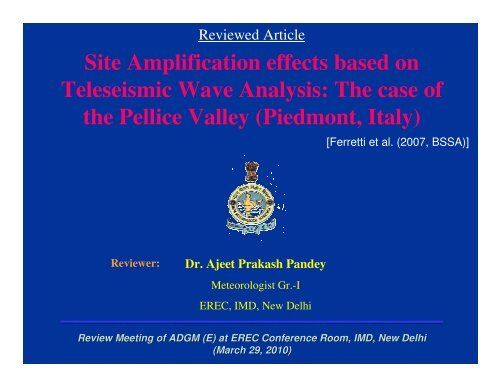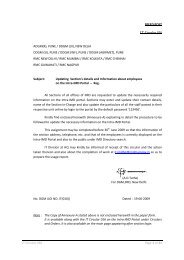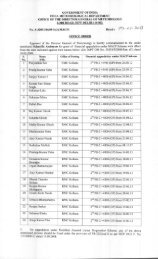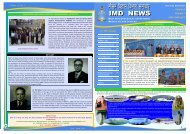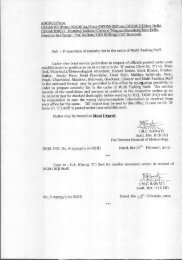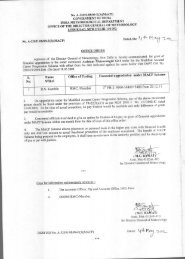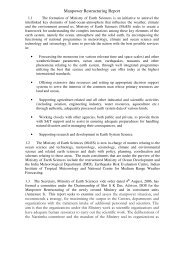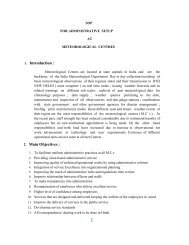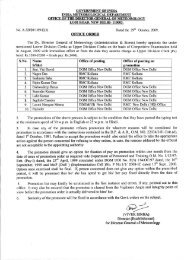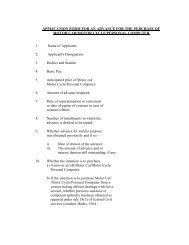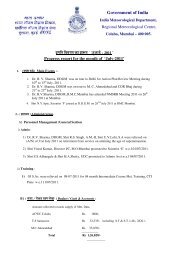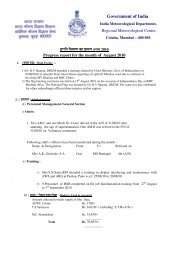Site Amplification effects based on Teleseismic Wave ... - METNET
Site Amplification effects based on Teleseismic Wave ... - METNET
Site Amplification effects based on Teleseismic Wave ... - METNET
You also want an ePaper? Increase the reach of your titles
YUMPU automatically turns print PDFs into web optimized ePapers that Google loves.
Reviewed Article<br />
<str<strong>on</strong>g>Site</str<strong>on</strong>g> <str<strong>on</strong>g>Amplificati<strong>on</strong></str<strong>on</strong>g> <str<strong>on</strong>g>effects</str<strong>on</strong>g> <str<strong>on</strong>g>based</str<strong>on</strong>g> <strong>on</strong><br />
<strong>Teleseismic</strong> <strong>Wave</strong> Analysis: The case of<br />
the Pellice Valley (Piedm<strong>on</strong>t, Italy)<br />
[Ferretti et al. (2007, BSSA)]<br />
Reviewer:<br />
Dr. Ajeet Prakash Pandey<br />
Meteorologist Gr.-I<br />
EREC, IMD, New Delhi<br />
Review Meeting of ADGM (E) at EREC C<strong>on</strong>ference Room, IMD, New Delhi<br />
(March 29, 2010)
Background<br />
One of the most important problems in Seismic Microz<strong>on</strong>ati<strong>on</strong><br />
studies is the evaluati<strong>on</strong> of site resp<strong>on</strong>se characteristics<br />
<str<strong>on</strong>g>Site</str<strong>on</strong>g> <str<strong>on</strong>g>effects</str<strong>on</strong>g> related to Geological and Geomorphological<br />
settings actually represent <strong>on</strong>e of the main factors resp<strong>on</strong>sible for<br />
building damage<br />
Local site amplificati<strong>on</strong> estimati<strong>on</strong> of an area by local seismic<br />
signal analysis is a fundamental step in defining the seismic<br />
resp<strong>on</strong>se of the area<br />
Regi<strong>on</strong>s characterized by low rate of seismicity, having<br />
potential of large damaging earthquakes, it is very difficult to<br />
assess the site resp<strong>on</strong>se through experimental methods, simply<br />
because of the lack of earthquake occurrences
C<strong>on</strong>td…..<br />
This problem could have been overcome by computing the<br />
horiz<strong>on</strong>tal to vertical (H/V) resp<strong>on</strong>se spectra for the regi<strong>on</strong> using<br />
Nakamura technique <str<strong>on</strong>g>based</str<strong>on</strong>g> <strong>on</strong> ambient seismic noise data<br />
Previous studies <str<strong>on</strong>g>based</str<strong>on</strong>g> <strong>on</strong> experimental data illustrate that the<br />
amplificati<strong>on</strong> derived from the H/V ratio of ambient noise<br />
measurements is almost always smaller than the <strong>on</strong>e obtained<br />
from earthquake data. However, fundamental frequencies of sites<br />
are Stable<br />
In this paper, use of teleseismic recordings at varied<br />
geological and geomorphological settings are investigated for<br />
assessing seismic wave amplificati<strong>on</strong> in the Pellice Valley<br />
(North-Western Alps, Italy) and the results are compared with<br />
that of Ambient Noise data as well as the Local Earthquake<br />
events
Objectives of the Study<br />
The prime objective of the study is to test whether <str<strong>on</strong>g>Site</str<strong>on</strong>g><br />
Resp<strong>on</strong>se may be estimated using <strong>Teleseismic</strong> Signals<br />
<strong>on</strong>ly, recorded at a dense temporary network<br />
In fact, horiz<strong>on</strong>tal to vertical spectral ratio of<br />
<strong>Teleseismic</strong> recordings are computed and the results are<br />
compared with that of local earthquake and ambient noise<br />
data<br />
Sec<strong>on</strong>dly, use of <strong>Teleseismic</strong> signal in establishing<br />
correlati<strong>on</strong> between depth of sedimentary coverage and<br />
computed P-phase arrival time delays & relative P-phase<br />
amplitude with respect to reference site
Geological Setup of Pellice Valley<br />
Pellice Valley is an Alpine Valley, located N-W of<br />
Piedm<strong>on</strong>t regi<strong>on</strong>, Italy<br />
Substratum characterized by Gneiss rock of Dora-Maria<br />
Massif superimposed with Quaternary ancient to recent<br />
Lacustrine and/or Palustrine deposits<br />
Four different geological settings of the study area –<br />
• On the edge of the Valley – Gneiss Outcrop<br />
• NW part of the study area – Alluvial fan deposits<br />
• Central part of the study area – Ancient deposits<br />
• Riverbed area – Recent fluvial deposits
Geological Map of Pellice Valley
Sub-surface Explorati<strong>on</strong> Surveys C<strong>on</strong>ducted<br />
Geophysical and Geotechnical field surveys are<br />
c<strong>on</strong>ducted for defining Physical – Mechanical Parameters<br />
of sub-surface materials as well as providing informati<strong>on</strong><br />
about the Geometry and depth to the Bedrock<br />
Different field surveys c<strong>on</strong>ducted in the study area –<br />
• 4 Boreholes – Geotechnical Investigati<strong>on</strong><br />
• 4 <str<strong>on</strong>g>Site</str<strong>on</strong>g>s – Down Hole Seismic test up to 50 m depth<br />
• 2 Profiles – Seismic reflecti<strong>on</strong> surveys c<strong>on</strong>ducted to<br />
c<strong>on</strong>strain Stratigraphy of deep<br />
sediments of more than 200 m &<br />
Topography of the bedrock<br />
• 9 Broadband Stati<strong>on</strong>s – Ensuring complete coverage<br />
(120 db) of the study area <strong>on</strong> all types of<br />
geological settings
Documentati<strong>on</strong> Map of Pellice Valley<br />
Seismic Stati<strong>on</strong>s<br />
Seismic Profiles<br />
Seismic Stati<strong>on</strong>s<br />
Boreholes<br />
<br />
<br />
<br />
<br />
9 temporary broadband seismic stati<strong>on</strong>s are used<br />
for teleseismic recording<br />
Sesimic stati<strong>on</strong> Pe03 lies <strong>on</strong> the rock and treated<br />
as Reference Stati<strong>on</strong> for the Study<br />
> 50 local events (M 2.0 – 3.5) recordings<br />
18 <strong>Teleseismic</strong> recordings
Methodology<br />
Adopted
Step-I<br />
Signal<br />
Signal to Noise Ratio for<br />
Stati<strong>on</strong>s Pe03, Pe06 &<br />
Pe07<br />
Noise<br />
Pe03<br />
Signal-to-Noise ratio<br />
(S/N) calculated using 20 s<br />
of pre-event noise and 20 s of<br />
seismic signal<br />
Noise<br />
Signal<br />
Pe06<br />
In 0.2 – 3.0 Hz frequency<br />
range, the level of teleseismic<br />
signals are much above the<br />
noise level<br />
Noise<br />
Signal<br />
Pe07
Step-II<br />
Horiz<strong>on</strong>tal to Vertical<br />
Spectral Ratio (H/V) for<br />
Teleseism<br />
20 s<br />
Window<br />
EQ: 08/02/2005; 15:05; 14.25<br />
S,167.26 E ; 206.0 km; M 6.8<br />
<strong>Teleseismic</strong> seismograms<br />
are dec<strong>on</strong>volved with<br />
Instrument resp<strong>on</strong>se and<br />
filtered by a 20 Hz low pass<br />
filter<br />
Fourier spectra calculated<br />
for windows of 20 s<br />
including the first and more<br />
energetic porti<strong>on</strong> of teleseism
Step-II<br />
(C<strong>on</strong>td…..)<br />
Fourier spectra pass through<br />
Hanning Window to enhance<br />
major features in the pass band<br />
Fourier spectra of the NS and<br />
EW comp<strong>on</strong>ents are averaged<br />
(root mean sqaure) to obtain<br />
horiz<strong>on</strong>tal comp<strong>on</strong>ent Fourier<br />
spectrum<br />
Fourier spectra of vertical<br />
comp<strong>on</strong>ent obtained<br />
Only 3 stati<strong>on</strong>s (Pe03, Pe06<br />
& Pe07) are used for the study,<br />
as other 6 stati<strong>on</strong>s could not<br />
record significant number (>3)<br />
of high quality teleseismic<br />
record<br />
20 s<br />
Window
Step-III<br />
Stability of H/V Spectral<br />
Ratios of <strong>Teleseismic</strong><br />
recording<br />
Different porti<strong>on</strong>s of<br />
teleseismic recording<br />
c<strong>on</strong>taining different teleseismic<br />
phases [P, PKP, PcP, pP, sP,<br />
sPKP etc.] are also used for<br />
H/V spectral ratio estimati<strong>on</strong>
Results<br />
H/V of Teleseisms<br />
are reliable in the<br />
frequency range 0.2<br />
– 3.0 Hz, as per S/N<br />
ratio analysis<br />
Rock site<br />
Reference Stati<strong>on</strong><br />
No amplificati<strong>on</strong> effect<br />
(Flat Resp<strong>on</strong>se)
Results<br />
H/V of Teleseisms<br />
are reliable in the<br />
frequency range 0.2<br />
– 3.0 Hz, as per S/N<br />
ratio analysis<br />
Ancient Fluvial<br />
Deposit<br />
Broad Peak between<br />
2.0 – 3.5 Hz<br />
C<strong>on</strong>firms Shallower<br />
Sedimentary Layer over<br />
Rock
Results<br />
H/V of Teleseisms<br />
are reliable in the<br />
frequency range 0.2<br />
– 3.0 Hz, as per S/N<br />
ratio analysis<br />
Recent Fluvial<br />
Deposit in Riverbed<br />
Peak <str<strong>on</strong>g>Amplificati<strong>on</strong></str<strong>on</strong>g> lies<br />
at 1.3 Hz<br />
C<strong>on</strong>firms Deeper<br />
Sedimentary Layer over<br />
Rock
Mapping of Valley Geometry<br />
<br />
<br />
<br />
<br />
Computati<strong>on</strong> of P-wave arrival time delays and<br />
relative amplitude of the initial P-waves carried<br />
out w.r.t. Pe03 reference stati<strong>on</strong><br />
C<strong>on</strong>sidering P-wave <strong>on</strong>ly in to account, the<br />
unprocessed teleseismic signal is bandpass filtered<br />
between 0.2 – 1.0 Hz, as per S/N ratio in<br />
relatively shorter window length<br />
P-wave time delays are carefully determined by<br />
cross-correlating the first quarter-cycle of the<br />
initial P-waveform of each stati<strong>on</strong> w.r.t. Pe03<br />
reference stati<strong>on</strong><br />
Also the amplitude ratio of the first P-wave<br />
arrivals are determined w.r.t. refrence stati<strong>on</strong>
Bed Rock<br />
X = Theoretical delay time derived c<strong>on</strong>sidering vertical propagati<strong>on</strong><br />
through 1D velocity structure below each stati<strong>on</strong>
Bed Rock<br />
X = Theoretical delay time derived c<strong>on</strong>sidering vertical propagati<strong>on</strong><br />
through 1D velocity structure below each stati<strong>on</strong>
Major Achievements of the Study<br />
Use of teleseismic recordings, in this study, are investigated for<br />
assessing seismic wave amplificati<strong>on</strong> in the Pellice Valley (North-<br />
Western Alps, Italy) and compared with the results obtained<br />
through local earthquakes as well as ambient noise data<br />
The reliability of the H/V results, obtained by the applicati<strong>on</strong> of<br />
a standard spectral ratio technique, c<strong>on</strong>sidering teleseismic<br />
recordings is c<strong>on</strong>firmed from both H/V of ambient noise data and<br />
H/V of S-wave of local events methods<br />
Accurate analysis of teleseismic data facilitates correlati<strong>on</strong><br />
between both P-wave travel time delays and its relative amplitude<br />
w.r.t. the bedrock topography and alluvial deposit thickness<br />
The case of the Pellice Valley shows that, in a regi<strong>on</strong><br />
characterized by a low seismicity rate, a spectral analysis <str<strong>on</strong>g>based</str<strong>on</strong>g> <strong>on</strong><br />
teleseismic signals could be an important tool to reliably define the<br />
site resp<strong>on</strong>se and the main geological structure of the valley


